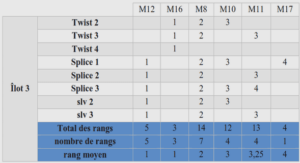Mesure des effets embryotoxiques de contaminants métalliques chez l’embryon d’escargot terrestre Helix aspersa
Cette partie à fait l’objet d’une publication acceptée en aoüt 2014 dans la revue Ecotoxicology and Environmental Safety. Les auteurs sont Pierre-Emmanuel Baurand, Nicolas Capelli, Renaud Scheifler et Annette de Vaufleury. Le bioessai en phase liquide utilisant les œufs d’escargot terrestre Helix aspersa permet d’évaluer l’embryotoxicité de contaminants variés via la mesure du taux d’éclosion. Les données obtenues via ce bioessai ne permettent qu’une mesure de toxicité en fin d’exposition (15 à 20 jours) comme l’a montré Druart et al. (2010, 2012) en mesurant le taux d’éclosion et en observant les malformations de l’embryon à des contaminants métalliques (Cd) ou organiques (RU®). Le but de ce travail est de trouver de nouveaux paramètres mesurables au cours du développement embryonnaire de l’escargot et pouvant rendre compte d’un effet toxique afin d’améliorer nos connaissances sur les effets du Cd chez l’embryon d’escargot. La recherche de ces critères de mesure a été calibrée lors d’une exposition en continue à 6 mg/L de Cd. Divers paramètres ont été suivis comme la taille des embryons après 3, 6 et 10 jours, les battements cardiaques à 7 jours, l’aspect des embryons non éclos à 17 jours, les retards d’éclosion et le poids des jeunes escargots éclos ou encore l’apparition d’une fragmentation de l’ADN. Enfin, les concentrations en Cd dans les œufs ont été mesurées pendant la durée de l’exposition. Les résultats montrent que les battements cardiaques diminuent chez les exposés alors qu’un effet sur la taille des embryons n’est visible qu’après 10 jours d’exposition (taille plus petite chez les exposés). Jusqu’à 75% des embryons non éclos à 17 jours sont malformés et morts. Un retard d’éclosion de 4 jours a été démontré chez les exposés. La fragmentation de l’ADN n’apparaît qu’en fin d’exposition (20 jours), ce qui démontre la faible sensibilité de ce critère de mesure. Les concentrations en Cd dans les œufs restent stables entre les jours 3 et 20 (19 à 27 µg/g MS).
For the past 15 years, early life stages (ELSs) have been the subject of numerous studies aimed at assessing the toxicity of chemicals, especially in aquatic environments (Gomot, 1998; Gopalakrishnan et al., 2008; Ismail and Yusof, 2011). Because the embryonic phase is an essential step in the life cycle and thus a key element of population dynamics (Laskowski, 1997; Caswell 2000), it is relevant to focus on this life stage. However, it has been relatively understudied until now, at least in terrestrial environments. Primarily for the ELSs of aquatic species, and particularly for mollusks, there is a large range of endpoints that can be measured to assess the embryotoxicity of pollutants from the molecular level (e.g., with genotoxicity assessment; Mai et al., 2012) to the physiological level (e.g., abnormalities, size, heart rate measurement; Schirling et al., 2006) and/or to the classical measurements of hatching rate or survival. More specifically, Gomot (1998) has shown rapid developmental arrests in eggs of the freshwater snail Lymnaea stagnalis exposed to 400 µg/L of cadmium (Cd) and has also reported anomalies during embryogenesis (e.g., foot formation, formation of the eyes).
In Lymnaea luteola L. eggs, Khangarot and Das (2010) showed that copper concentrations from 100 to 320 µg/L caused incomplete development of the foot, eyes, tentacles and digestive gland, shell thinness, developmental arrests and delays in hatching. These parameters (mortality, hatching success) or developmental endpoints (e.g., size of embryos, malformations, growth inhibition) have been applied to characterize the embryotoxicity to L. stagnalis of various compounds such as tributyltin (TBT) and common solvents (Bandow and Weltje, 2012), surfactants (Mazur et al., 2013) and lead (Munley et al., 2013). In another aquatic snail (Marisa cornuarietis), the use of endpoints such as the formation of eyes and tentacles, heart rate, egg hatching rates and weight after hatching allowed the evaluation of the effects of various contaminants: solvents, an artificial hormone (EE2), Cd (Schirling et al., 2006), zinc, nickel and pesticides (Sawasdee and Kohler, 2009). Eggs of the snail Biomphalaria glabrata were used by Ansaldo et al. (2009) to find useful parameters for a toxicity bioassay after 96 h of exposure to different concentrations of trace elements: lead, Although various complementary endpoints are available for measuring the toxicity of pollutants in the ELSs of aquatic snails, few data concerning terrestrial species whose eggs are incubated in the soil are available. It is probable that one reason for this scarcity is the presence of a calcareous capsule surrounding the eggs, which prevents simple observations of embryogenesis and, thus, of the developmental effects of chemicals.



